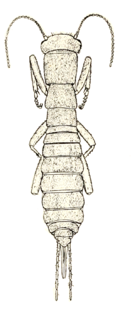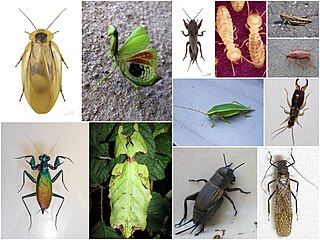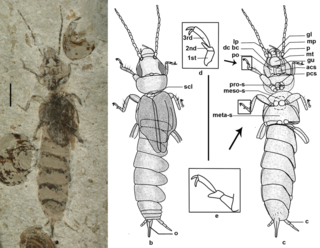
Pygidicranidae is a family of earwigs, formerly placed in the suborder Forficulina, now in the suborder Neodermaptera. The family currently contains twelve subfamilies and twenty six genera. Eight of the subfamilies are monotypic, each containing a single genus. Of the subfamilies, both Astreptolabidinae and Burmapygiinae are extinct and known solely from fossils found in Burmese amber. Similarly Archaeosoma, Gallinympha, and Geosoma, which have not been placed into any of the subfamilies, are also known only from fossils. Living members of the family are found in Australia, South Africa, North America, and Asia. The monotypic genus Anataelia, described by Ignacio Bolivar in 1899, is found only on the Canary Islands. As with all members of Neodermaptera, pygidicranids do not have any ocelli. The typical pygidicranid bodyplan includes a small, flattened-looking body, which has a dense covering of bristly hairs (setae). The pair of cerci at the end of the abdomen are symmetrical in structure. The head is broad, with the fourth, fifth and sixth antenna segments (antennomeres) that are not transverse. In general Pygidicranids also have equally sized ventral cervical sclerites, and in having the rearmost sclerite separated from, or only touching the center of the prosternum. Cannibalism of young has been observed in at least one species in the family, Challia hongkongensis, in which an adult female was found eating a still-living nymph of the same species. The same species in a different area has been observed possibly eating fruits or seeds, making the species an omnivore.

Arixeniidae is a family of earwigs in the suborder Neodermaptera. Arixeniidae was formerly considered a suborder, Arixeniina, but was reduced in rank to family and included in the new suborder Neodermaptera.
Protodiplatyidae is an extinct family of earwigs. It is one of three families in the suborder Archidermaptera, alongside Dermapteridae and Turanovia. Species are known from Jurassic and Early Cretaceous fossils and have unsegmented cerci and tarsi with four to five segments.
Microdiplatys is an extinct genus of earwigs, in the family Protodiplatyidae. It is one of only six genera in the family, its family being the only one in the suborder.
Archidermapteron martynovi is an extinct species of earwig, in the genus Archidermapteron, family Protodiplatyidae, the suborder Archidermaptera, the order Dermaptera, and is the only species in the genus Archidermapteron, which simply means "ancient member of the Dermaptera". It had long, segmented cerci unlike modern species of Dermaptera, but tegmina and hind wings that folded up into a "wing package" that are like modern earwigs. The only clear fossil of the species was found in Russia.
Asiodiplatys is a monotypic genus containing the single species Asiodiplatys speciousus, an extinct species of earwig in the family Protodiplatyidae. It had long and thin cerci that were very different from modern species of Dermaptera, but tegmina and hind wings that folded up into a "wing package" that are like modern earwigs. Like Archidermapteron martynovi, the only clear fossil of the species was found in Russia.
Microdiplatys oculatus is an extinct species of earwig in the family Protodiplatyidae. It is one of only two species in the genus Microdiplatys, the other being Microdiplatys campodeiformis.

Diplatyidae is a family of earwigs in the suborder Neodermaptera. It contains only one subfamily, Diplatyinae, which contains six genera, five modern and one extinct known from fossils. The genus Tytthodiplatys was described in 2011 from a fossil found in Burmese amber which dates to the Albian age of the Cretaceous. It was not placed into the subfamily Diplatyinae, and is the oldest confirmed member of the family.
Anisolabis howarthi is a blind, troglobite species of earwig in the genus Anisolabis, the family Anisolabididae, the suborder Forficulina, and the order Dermaptera. The species is native to Hawaii, and was first classified by Brindle in 1979. According to a paper published by him in 1980 in the journal Pacific Insects, the species is first known true troglobite earwig; while there are other blind species that live underneath soil or humus, this is the first to actually inhabit a cave.

Grylloblatta campodeiformis, also known as the northern rock crawler, is an omnivorous species of insect in family Grylloblattidae. Like other species in the genus Grylloblatta, it is endemic to North America.

Labidura is a genus of earwigs in the family Labiduridae.

The Trigonopterygoidea are an insect superfamily in the Orthoptera: Caelifera. Sometimes described as leaf grasshoppers, American species in the Xyronotidae have also been called razor-backed bush-hoppers.

The cohort Polyneoptera is a proposed taxonomic ranking for the Orthoptera and all other Neopteran insects believed to be more closely related to Orthoptera than to any other insect orders. These winged insects, now in the Paraneoptera, were formerly grouped as the Hemimetabola or Exopterygota on the grounds that they have no metamorphosis, the wings gradually developing externally throughout the nymphal stages.

Psyllipsocidae is a family of cave barklice in the order Psocodea. There are about 7 genera and more than 70 described species in Psyllipsocidae.
Elipsocus is a genus of damp barklice in the family Elipsocidae. There are more than 20 described species in Elipsocus.
Diaperasticus is a genus of earwigs in the family Forficulidae. There are about six described species in Diaperasticus.
Semenoviolidae is an extinct family of earwigs in the order Dermaptera. There are at least two genera and two described species in Semenoviolidae.
Turanodermatidae is an extinct family of earwigs in the order Dermaptera. There is one genus, Turanoderma, in Turanodermatidae.

Eodermaptera is an extinct suborder of earwigs known from the Middle Jurassic to Mid Cretaceous. Defining characteristics include "tarsi three-segmented, tegmina retain venation, 8th and 9th abdominal tergite in females are narrowed, but separate from 10th tergite and not covered by 7th tergite and exposed ovipositor" They are considered to be more closely related to Neodermaptera than the more basal Archidermaptera.

Chelidura is a genus of earwigs in the family Forficulidae.









